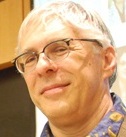7.6: DNA, sequences, and information
- Page ID
- 4561
We can now assume that somehow the sequence of nucleotides in a DNA molecule encodes information but exactly what kind(s) of information are stored in DNA? Early students of DNA could not read DNA sequences, as we can now, so they relied on various measurements to better understand the behavior of the molecule. For example, the way a double stranded DNA molecule interacts with light is different from how a single stranded DNA molecule does. Since the two strands of double stranded DNA molecules (often written dsDNA) are attached only by hydrogen bonds, increasing the temperature of the system will lead to their separation into two single stranded molecules (ssDNA). ssDNA absorbs light at 260nm (in the ultraviolet) more strongly than does dsDNA, so the absorbance of a DNA solution can be used to determine the relative amounts of single and double stranded DNA in a sample. What we find is that the temperature at which 50% of dsDNA molecules have separated into ssDNAs varies between organisms. This is not particularly surprising given Chargaff’s observation that the ratio of AT to GC varied between various organisms and the fact that GC base pairs, mediated by three H-bonds, are more stable than AT base pairs, which are held together by only two H-bonds. In fact, one can estimate the AT:GC ratio based on melting curves.
It quickly became clear that things are more complex than previously expected. Here a technical point needs to be introduced. Because of the extreme length of the DNA molecules found in biological systems, it is almost impossible to isolate them intact. In the course of their purification, the molecules will be sheared into shorter pieces, typically thousands of base pairs in length compared to the millions to hundreds of millions of base pairs in intact molecules. In another type of experiment, one can look at how fast ssDNA (the result of a melting experiment) reforms dsDNA. The speed of these “reannealing reactions” depends on DNA concentration. When such experiments were carried out, it was found that there was a fast annealing population of DNA fragments and various slower annealing populations. How to explain this result, was it a function of AT:GC ratio? Subsequent analysis revealed that it was due to the fact that within the DNA isolated from organisms, particularly eukaryotes, there were many (hundreds to thousands) of regions that contained similar nucleotide sequences. Because the single strands of these fragments can associated with one another, these sequences occurred in much higher effective concentrations compared to regions of the DNA with unique sequences. This type of analysis revealed that much of the genome of eukaryotes is composed of various families of repeated sequences and that unique sequences amount to less than ~5% of the total DNA. While a complete discussion of these repeated sequence elements is beyond our scope here, we can make a few points. As we will see, there are repair mechanisms that can move regions of a DNA molecule from one position to another within the genome. The end result is that the genome (the DNA molecules) of a cell/organism are dynamic, a fact with profound evolutionary implications.
Questions to answer & to ponder
- Which do you think is stronger (and why), a AT or a GC base pair?
- Why does the ratio of A to G differ between organisms?
- Why is the ratio of A to T the same in all organisms? What does this imply about the presence of single and double stranded DNA in an organism?
- What does it mean that the two strands of a DNA molecule are anti-parallel?
- Normally DNA exists inside of cells at physiological salt concentration (~140 mM KCl, 10 mM NaCl, 1mM MgCl2 and some minor ions). Predict what will happen (what is thermodynamically favorable) if you place DNA into distilled water (that is, in the absence of dissolved salts.)
Contributors and Attributions
Michael W. Klymkowsky (University of Colorado Boulder) and Melanie M. Cooper (Michigan State University) with significant contributions by Emina Begovic & some editorial assistance of Rebecca Klymkowsky.


